Welcome to Readialand
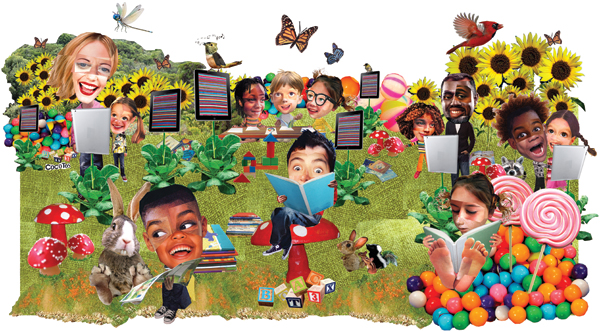
Illustration by Tom Nick Cocotos
How do you score on digital literacy? Take the quiz
A new wave of programs is taking advantage of technology to support and coach families on child development and the appropriate role of digital tools in building early literacy skills.
This balanced—and realistic—approach is what Michael H. Levine, founder and director of the Joan Ganz Cooney Center, and Lisa Guernsey, director of the New America Foundation’s Learning Technologies Project, call “Readialand.” It’s an environment in which interactive technology is harnessed to improve children’s access to learning opportunities and potentially reduce gaps in literacy skills between children from lower- and higher-income families.
“Whether it is a text message to nudge adult-child verbal interaction, a community program that is teaching bilingual children to compose their own video narratives, or a well-designed parenting or literacy app, well-deployed technology can be a powerful element of a new strategy to address America’s literacy crisis,” says Levine.
Guernsey and Levine have undertaken extensive research on how tech is being used to prepare and teach young children to read. At the same time, they reinforce the necessary role of parent-child interaction that scientists refer to as “serve and return,” an exchange that positively shapes brain development. These concepts are central to their book, Tap, Click, Read (Jossey-Bass, 2015), and an active website of the same name, which has additional resources.
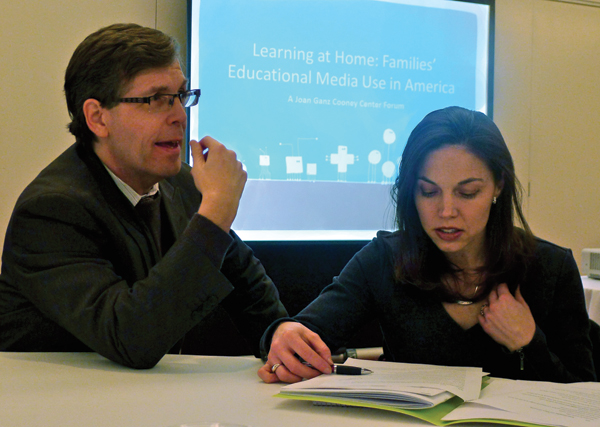
Michael H. Levine (left) and Lisa Guernsey
A ‘third way’ to engage
“The digital age brings a paradox,” Guernsey and Levine write. “As workplaces become increasingly dependent on the exchange of information, good reading skills become more important than ever.” However, with the ubiquity of digital distractions that affect reading and communication, they ask, “How will children ever learn to read?”
Digital media doesn’t have to be a distraction that steals young children’s attention away from print, they argue, nor is it the ultimate solution for enticing pre-readers through sounds, videos, and colorful characters. Rather, websites and apps can be vehicles for prompting meaningful conversations with children that increase their background knowledge. An interactive map shows the locations of more than 30 parenting and early education programs nationwide that are using new technologies to support language development and children’s early literacy skills.
“We argue for a modern, ‘third way’ approach to technology that gives young children of all backgrounds more opportunities to learn to read and succeed in the 21st century,” Guernsey explained in a NPR interview. “We need to get past the tired nagging of ‘no screen time’ and the overheated enthusiasm over apps as the holy grail of early education.”
In early August, the Cooney Center and New America will host a two-day institute, “Language Development and Family Engagement in the Digital Age,” convening researchers, policymakers, and program designers. Part of the event will highlight ways in which librarians are serving as “media mentors,” guiding families toward the best digital resources, and will feature Claudia Haines, youth librarian at the Homer (AK) Public Library. More broadly, participants will discuss ways to scale up evidence-based family engagement and education strategies that “capitalize on media and technology tools.”
Adapting a successful parenting program for the digital age is one way to create more learning opportunities and potentially reduce literacy gaps among children.
In one such program, based in Los Angeles, the University of Southern California’s (USC) Telehealth clinic is delivering Parents as Teachers (PAT), a 35-year-old home-visiting model, entirely through interactive, web-based technology. PAT, which exists in 50 states and several other countries, provides families facing poverty and other challenges with regular home visits during the first two years of their child’s life. The parent educators can also follow up until the child is ready to enter school. In addition to giving families books, blocks, a family journal, and other learning materials, cohorts of parents gather for peer support, sometimes in local libraries.
Seven interns who are earning their master’s in social work (MSW) currently serve 65 families in the Los Angeles area. With the Telehealth model, families also receive an iPad, if they don’t have one, to connect with their parent educator.
The second time MSW student Crystal Sabala met with one of the families in her home-visiting caseload, the parents and aunt sat in their kitchen while video chatting with Sabala. The physical distance wasn’t a barrier to focusing on safe home environments for the five-month-old boy or celebrating his first two teeth.
“I was quite honored that my client felt so comfortable with me that she saved me a spot at their kitchen table,” Sabala says. “The rapport that has been established in such a short time is simply amazing.”
Dorian Traube, the leader of the USC project and an associate professor who specializes in preventing child maltreatment, says that she expected most home-visiting programs to turn down the idea of going online, considering face-to-face interaction as a must. But PAT had already been piloting an online version.
“They were over that hurdle,” Traube says. “More and more people are comfortable with technology and rely on it. We have now been approached by other models for advice on how to do this.”
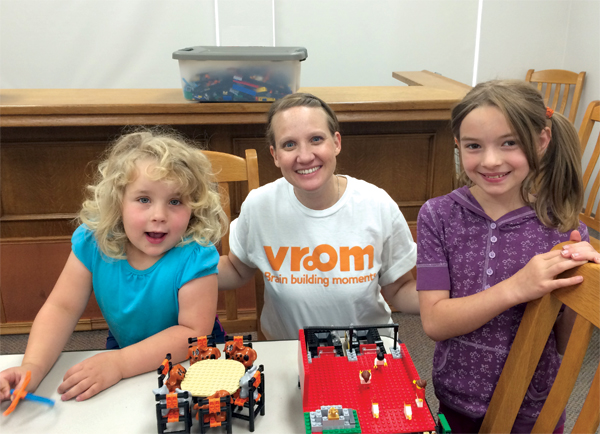
The Bezos Family Foundation’s Vroom early learning initiative partners
with libraries, including those in the Baker County (OR) district.
‘Aha!’ moments
Then there’s Vroom, a website and a mobile app from the Bezos Family Foundation that provides parents with information on their child’s brain development and ways to encourage learning during everyday activities. Partnering with brands such as Goya food products, media companies including Univision, and a wide variety of community early learning organizations, Vroom aims to influence parents’ behavior through products and programs they already trust.
“What we set out to do at the beginning was to help parents across the country to have their own ‘aha!’ moment about what is happening in the first five years,” says Megan Wyatt, managing director of strategy and programs for early learning at the Bezos Family Foundation. “The goal of Vroom is to highlight the brain-building potential in everyday moments.”
Libraries are helping in this effort. In April, the South Manatee Library in Bradenton, FL, for example, hosted an event in which representatives of the Suncoast Campaign for Grade-Level Reading introduced the Vroom app to parents and provided assistance downloading it. In rural eastern Oregon, the Baker County Library District promotes Vroom in multiple ways, including putting Vroom stickers on giveaway items and through social media. Librarians ask parents to sign up for the app at storytimes, and work with local health care providers to “prescribe” a visit to the library, according to Ari Wubbold, Vroom coordinator for the Oregon Department of Education’s Early Learning Division.
“When we think about trusted messengers, libraries have been very important players in community activation,” Wyatt says.
Texting strategies
The strategy of text messaging to remind parents to read with their children or spend time in other educational activities has also yielded positive results. Researchers at the University of Chicago’s Behavioral Insights and Parenting Lab implemented a six-week intervention, Parents and Children Together (PACT), in which they gave English- and Spanish-speaking parents with children in Head Start a tablet computer with a library of 500 digital storybooks. They asked the parents to set reading goals and sent them daily text reminders to read with their kids. The parents could view their progress with an app that recorded time they spent reading, and they were recognized for meeting weekly goals.
The parents in the experimental group spent more than twice as much time reading with their kids as those in a control group, which got the device but not the reminders and recognition.
Over the six-week project, experimental group parents read for an average of 152 minutes, compared to 63 for the control group. When researchers checked in on the families three months later, they found that parents who had received text reminders were still reading to their kids for twice as long.
Researchers Ariel Kahil and Susan E. Mayer write that because of the small sample size, conclusions can’t be drawn. However, the findings still “suggest a persisting difference in the amount of time parents spent reading to their children.”
Library systems across the country—including the Brooklyn (NY) Public Library, Dayton (OH) Metro Library, Frisco (TX) Public Library, Darien (CT) Library, and Oak Park (IL) Public Library—have also started early literacy texting campaigns in addition to on-site activities.
The Brooklyn Public Library (BPL) now has 650 subscribers to its Ready, Set, Kindergarten (RSK) on the Go! program, which provides literacy tips for parents of three- to five-year-olds.
“Parents responded well to activities they could do anywhere—on the bus, the walk to school, or the doctor’s office,” Jessica Ralli, coordinator of early literacy programs at BPL, and Rachel Payne, BPL’s coordinator of early childhood services, wrote in an SLJ article last year. Their initiative was inspired by a text messaging program and study, Ready4K!, created by researchers at Stanford University. In the study, parents of children attending preschool in the San Francisco area received weekly text messages with simple reminders on how to build their children’s early literacy skills, such as pointing out rhyming words or saying words that start with the same letter sound. The study showed that the program increased the amount of time parents reported spending on early literacy activities in their home.
BPL is now launching a second texting campaign, Read, Play, Grow on the GO!, to complement the library’s curriculum for families with infants and toddlers.
Respecting parents’ culture and traditions, however, is just as important in digital communication as it is when meeting face-to-face, says Gigliana Melzi, an associate professor in the Department of Applied Psychology at New York University.
“If the suggestions for the activities are grounded within parents’ socio-cultural reality and background, it can be quite valuable,” she says. “Oftentimes, however, well-intended efforts can be disrespectful to the families. They assume that parents don’t care, don’t know how to support their children because they do things differently. Finding the right balance is key.”
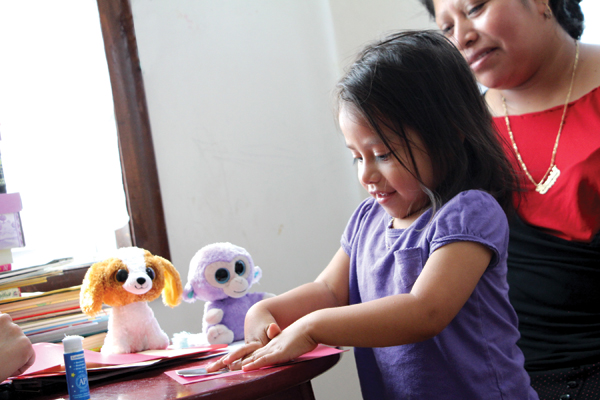
The Providence Talks initative emphasizes the quality of dialogue
between parents and children as they build vocabulary.
The word gap
Other programs that Guernsey and Levine studied focus on reducing the vast word gap that researchers have found to exist between young children growing up in poverty and those from higher-income families. Programs in cities including Chicago, IL and Providence, RI, use tech to record exchanges between parents and children with the goal of making conversation a regular part of their routine.
“My focus is on parents as agents of change in education,” says Courtney Hawkins, executive director of Providence Talks, a citywide initiative now serving 650 families and the grand prize winner in the 2012–13 Bloomberg Philanthropies Mayor’s Challenge. When parents change their behavior, Hawkins says, “that helps kids forever.”
Families that qualify for the program receive a device created by the LENA Research Foundation, which acts as a “word pedometer.” Over an eight-month period, they also receive 13 visits from a coach who reviews weekly data reports with them and focuses on tips, such as asking open-ended questions and other skills aligned with the Rhode Island Early Learning and Development Standards.
“The best and most rewarding part of this program is giving the parents the confidence to do so many different things with their child,” says Ashley Cardin, a Providence Talks coach. “Most of the families thrive on seeing their report each week and always want to do more and be better for the next one.”
With the goal of serving 2,500 families by the end of 2017, the program is being delivered in three formats, the first being the individual home visit. In the second model, participants gather for group sessions in libraries, churches, and other community locations over 10 weeks. Hawkins says that this more intensive model “adds this component of peer support.” The third will focus on child-care providers, since many infants and toddlers spend more time with caregivers during the day than with parents.
“We are seeing families make progress in terms of words and interaction,” and children’s scores on developmental assessments are improving, Hawkins says.
Melzi notes that while increasing young children’s vocabulary is an important step in learning to read, it’s not enough. “That number of words or vocabulary size is not the only measure that counts,” she says. “There is research that suggests, for instance, that the number of rare words is quite critical. Children's ability to create and tell a story is another important skill.”
Hawkins notes that the word pedometer device also measures word exchanges, an indication that the adults and the children in the home are conversing. The team plans to follow up to see if the changes hold over time. “If you’re yelling at a kid, there is less interaction,” she says. “The exchange number is really getting at this issue of the quality of engagement.”
Opportunities for all
A key part of Guernsey and Levine’s message is making sure parents and others who work with children, including teachers and librarians, become better educated at how to find high-quality apps and digital tools for kids.
The best programs incorporate information on the productive ways children can use apps, online games, and other media. “PAT folds that into conversations on television and the healthy use of technology,” says Traube at USC. “It can be an amazing feature to use with your child.”
Traube would also like to give the families access to downloadable books once their children move past the “touch-and-feel book” stage.
Recognizing technology’s limitations in a young child’s world is also important, Melzi says, noting that many traditional learning tools are still valid. “Children can learn from both, but they need to touch, experience, and do to learn,” she says.
Guernsey and Levine don’t propose that digital media and new tech will rescue schools and save the world. They do believe, however, that as tech advances, all families must have access to the learning opportunities that it can offer. Noting that two-thirds of American children are not reading proficiently, they argue, “We cannot allow technology to exacerbate social inequality instead of opening up more opportunities for everyone to succeed.”
The Three C’s: Content, Context, and Your Child
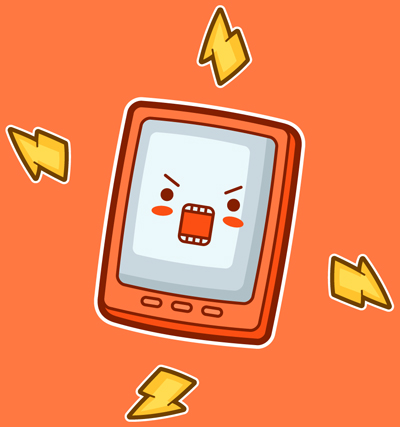 Do you leave the screen on when no one’s watching? If the answer is yes, it’s time to reflect on the media environment your children or students are experiencing and what you can do to improve it. Take this quiz from the Tap, Click, Read site to find out how you can become more mindful in using digital technology with young children.
Do you leave the screen on when no one’s watching? If the answer is yes, it’s time to reflect on the media environment your children or students are experiencing and what you can do to improve it. Take this quiz from the Tap, Click, Read site to find out how you can become more mindful in using digital technology with young children.
Content
Is your child watching media or playing games that are violent, scary, or troubling to him/her? -2 Are the characters modeling positive social skills? +1 Are the media designed to promote conversation or help build language skills? +1 Do media stimulate off-screen comments or questions? Off-screen play? Creation, imagination, exploration? +2 Do media feature some of the same traits you are looking for in a teacher or classroom? +1
Your “Content” score ______
Context
Are you leaving the screen or TV on even when no one’s watching? -2 Are media replacing calming routines that could help during bedtime? -1 Do you have moments in which you are jointly watching or playing with your child? +2 After your child watches or plays, are there chances to talk about what was seen or played? +1 Are screen media used during meal times in a way that impedes conversation? -1 Do you talk to your child about your use of TV, video, tablets, or e-readers and what you find valuable about them? +1 Do you tune out and miss cues from your child when using your devices or screen media? -2
Your “Context” score ______
Your Child
Do you see particular media experiences assisting your child as he/she progresses in motor skills, social skills, or language development? +1 Have you started to differentiate between media experiences that are not helping your child’s development and those that are? +1 If you find that your child gets upset when watching certain types of content, do you watch with him/her or find ways to avoid that media? +1 Are you paying attention or asking enough questions to tell whether your child is engaged by what is on screen? Does he or she act on or talk about what he or she sees or plays with? +1
Your “Your Child” score ______
How does your total score reflect your habits? Find out!
Check out a wealth of tips and insight on other topics, from using media to support children’s home language to identifying high-quality apps, on the Tap, Click, Read site. This material is also available from First Book Marketplace, a site offering discounts on books and educational materials for schools and programs serving children from low-income families.
Reprinted with permission from Lisa Guernsey and Michael H. Levine.
RELATED
The job outlook in 2030: Librarians will be in demand
The job outlook in 2030: Librarians will be in demand
ALREADY A SUBSCRIBER? LOG IN
We are currently offering this content for free. Sign up now to activate your personal profile, where you can save articles for future viewing






Add Comment :-
Be the first reader to comment.
Comment Policy: